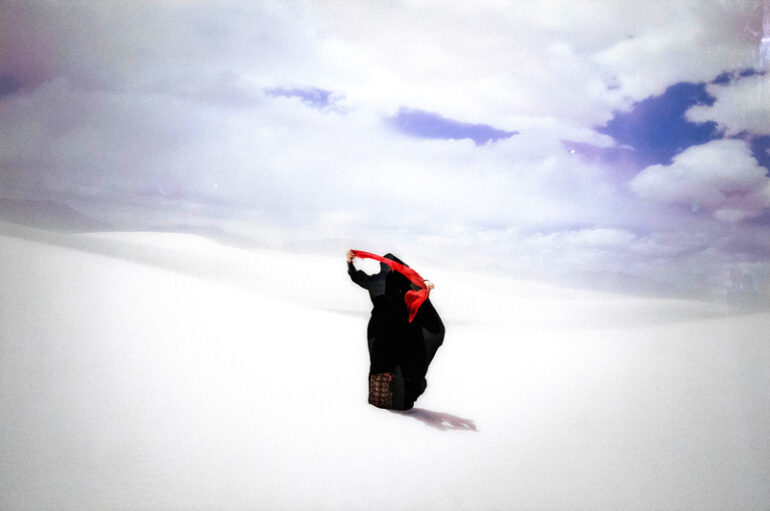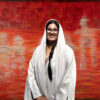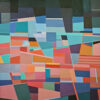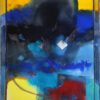An in-depth look at Sama Al Shaibi’s mid-career survey exhibition at Maraya Art Centre in Sharjah.
Somehow, in a masterful stroke of balance, Sama Alshaibi manages to be herself, to embody her life’s own narrative and all its complexities but also, contain within that self, the stories of an entire region, riddled with conflict, displacement and forced migration as well as the global ecological crisis. Through her multimedia art practice, Alshaibi’s uses her body as a site of performance, which is usually present in her work as the protagonist but never quite as herself. In Silsila, perhaps her best known and longest running project, beginning in 2009, she loosely followed the path of the 14th century Moroccan explorer Ibn Battuta through present-day Middle East and North Africa and then further afield to the Maldives and Hawaii. The result was a series of photographs and videos, which reference the relationship between humanity and the natural world and in which Alshaibi, dressed in flowing robes that echo the movements of wind or water, is seen at one with the landscape. The artist is making a complex commentary on issues of man-made geographical borders as well as the environmental disasters affecting our waterways. She says that one of the crucial elements of her performances was staying fully present, therefore conveying two connections: that to the water, which is a life source to all regardless of nationality and that to the land, which has held a traumatic personal narrative throughout her life.
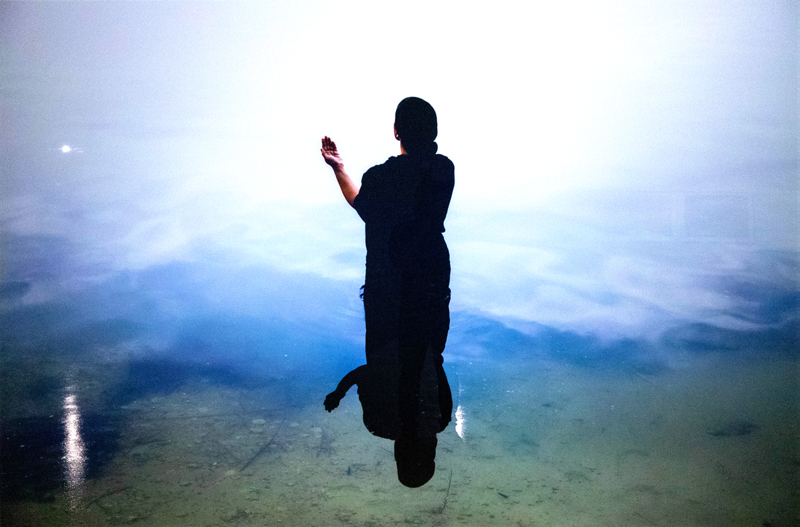
“Silsila creates the opportunity to think of the region as a whole, where water and sand drift without borders and the protagonist moves unencumbered by divisions,” said Alshaibi.
Born in Basra to an Iraqi father and Palestinian mother, Sama Alshaibi’s family were forced to flee Iraq in the 1980s and she now lives and works in the United States. Migration and restrictions of travel as well as a longing for her dual motherlands have informed her work. Using her own body as a metaphor for the physical and ongoing repercussions felt by war, exile, power and the quest for survival, Alshaibi uses what she calls an “embodied practice” symbolising issues, people and concepts through the channel of herself.
The multiple layers – biological, ecological, historical and symbolic – are all simultaneously at play in Alshaibi’s mid-career survey running at Sharjah’s Maraya Art Centre until June 2023. Tell it to the River brings together significant parts of her practice over the past two decades and also debuts two commissions, one of them being Ihyiaa, a 12-minute video that marks the end of the Silsila project with a final chapter, the long awaited return to Iraq.
Cima Azzam, who co-curated Tell it to the River alongside Mo Reda, said: “In Silsila, Sama was trying to move as freely as Ibn Battuta did centuries ago; to travel without borders and to move from one place to another without identifying which land it is. She was re-enacting his footsteps in a time-travelling body but at the heart of it all was also a journey – she was trying to get to Iraq.”
Ironically, it was only after she was granted American citizenship that Alshaibi was able to first visit Palestine and then, after 40 years in exile, finally return to Iraq in 2021. And this is the key that ties the exhibition together.


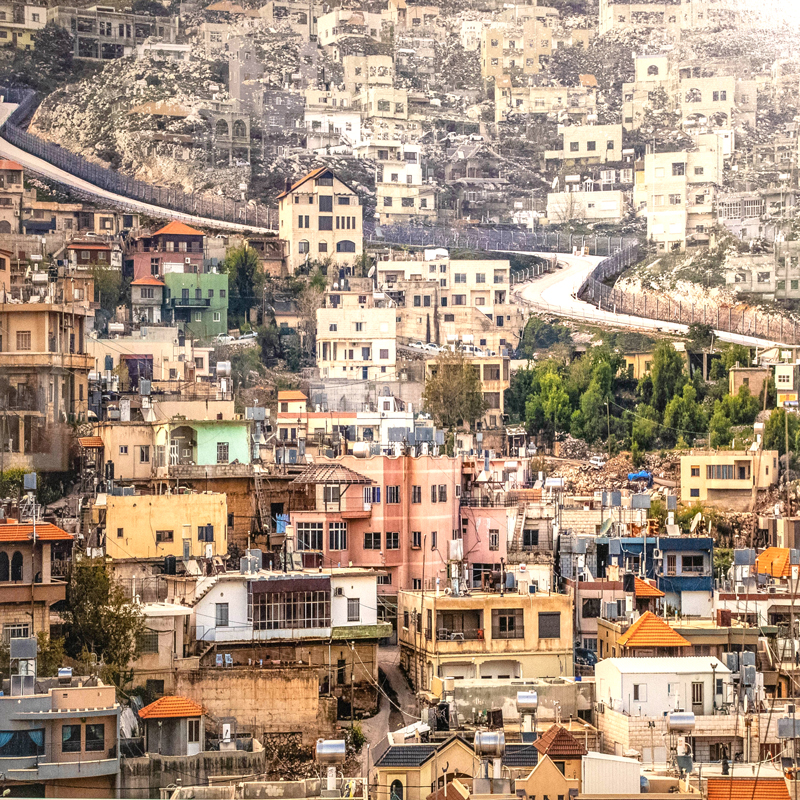
Installation view from the Contested Land series exhibited as part of Tell It To The River at Maraya Art Centre, Sharjah. March – June 2023 and loaned to the exhibition courtesy of Barjeel Art Foundation. Photo by Bernard Jouaret, image courtesy of Maraya Art Centre.
During COVID, Alshaibi submitted a proposal for the Guggenheim Fellowship focusing on Iraq and more specifically the concept of public space. She proposed that during her return to the country, she would record the experience with a LiDAR – a remote sensing method that uses light in the form of a pulsed laser to measure ranges. She was awarded the 2021 Guggenheim Fellowship.
But as she visited Baghdad and was between Iraq and Sharjah preparing for the Maraya exhibition, she was gripped by the sudden need to go back to the marshes outside of Basra, the place of her birth. There, she said, the epilogue to the Silsila story was waiting to be written.
“It was the missing part of the puzzle that she hadn’t realised was missing,” said Azzam. “The Silsila project was an eight-year cycle that ended in 2017 but when Sama was with me in the UAE and discussing the current exhibition, the idea for Ihyiaa was taking shape.”
The ensuing video, which was shot over 48 hours on the Mesopotamian Marshes in December 2022, is a powerful depiction of Alshaibi traversing narrow canals through the wetlands in a wooden canoe, boldly facing the camera and showing her face for the first time in the Silsila project.
“She is older, she is wiser, and she is reckoning with the land itself as well as the audience,” said Alshaibi. “I am calling it the final chapter but it is also its own thing.”
The central part of the video, made using a reverse filming technique, shows the protagonist collecting reeds from the marshes as an impactful act of reclamation.
“She is giving back to the land the life that it has lost, both in her own memories but also from the ongoing destruction of war that affects not just humans but the natural world,” said Azzam.
As well as a homecoming triumph, it is also an apocalyptic warning that this land, and these marshes, on the floodplains of the Euphrates and Tigris – the veritable cradle of civilization and birthplace of all humanity – are under threat because of war and humanity’s divisions. In this climax to Silsila, Alshaibi has portrayed the message that climate change, natural disasters and the need for fresh water are as borderless as Ibn Battuta himself.
“Silsila was a decade of me talking about the end of fresh water in the Middle East and that those will be the next kind of wars – the water wars – and the next kind of forced migrants will be eco-migrants. That is already happening,” said Alshaibi.
However, the piece is titled Ihyiaa which the artist translates to revival, revealing the fact that it was also a pivotal point in her life and career, uncovering deeply rooted memories.
“Being on the marshes that day was like an ‘a-ha’ moment for me to understand major motifs in my work, like bird sounds,” she said. “I had always used birds as a metaphor for migration but when I was in the marshes, in that river, I realised these were the sounds of my earliest childhood that I had replaced with bombs, sirens and the sounds of war. It was a return to something very physical that I had been chasing my whole life without realising.”
She said she experienced a similar revival whilst shooting in Baghdad for the Guggenheim Fellowship Project, the first part of which is revealed in this exhibition and titled Prelude to The Round City. Alshaibi explained that her return to Iraq was so emotional that her embodied practice was almost impossible to maintain as she was flooded with memories, both conscious and subconscious of a place that she belonged but that also felt alien.
The resulting artwork Prelude to the Round City, which is installed in an almost complete circular structure made of black scrim (semi-transparent) screens and modelled on the architecture of the city itself, mirrors this feeling of intensity and memory but also of alienation. The images on the screen are difficult to identify at times, they appear blurred or ghostly, the way memories flicker in the mind. The images are also not choreographed as with previous projects, the LiDAR exists as an all-seeing eye as well as something not ‘of’ the place. “The LiDAR was actually the perfect instrument for this work,” she said. “Because unlike a camera I didn’t have to make any decisions in the moment, it was just recording everywhere around me and even beyond where I could see. Here, the LiDAR became my body – it was a poetic analogy to my experiences and also a comment on how much you can render the visual, textual understanding of a space when you are in it.”
Observing the installation is a sculpture of Scheherazade made from neon light strips and suspended in scaffolding tubes. “Scheherazade resembles a woman that used everything but her sexuality to survive,” explained Azzam, “and in that sense this artwork is a metaphor for Iraq. The country is surviving through its intellectual community; it is the cultural hub of the Middle East and some of the best art and creativity comes from Iraq.”
So, if Iraq is the Scheherazade of our times, a symbol of resilience against adversity, then there is still hope for the dying Mesopotamian marshes. Although the artist shuns the word hope, preferring something grittier and more realistic, especially in the context of seemingly inevitable environmental catastrophe, there is a certain positivity to the exhibition as the whole. And that comes from the banks of that river, inside the marshes, where she had her moment of actualisation and after which the exhibition is named. Tell it to the River is a kind of American slang phrase indicating that people are tired of hearing the same story over and over again and that only the river will listen, but it also points to the wisdom and age of the waterway.
“The river is ancient and old and it feels sacred, there is a kind of resilience in it,” said Alshaibi. “It is the first witness; it has seen everything from the beginning of civilisation, carrying with it suffering, pain, and each time starting anew. Although it seems like it is dying, in all senses we feel it will outlast us.”
This is a personal story, a social story, an ecological story, an allegory, history and the future. Whilst it is very much one woman’s journey, it is also pulls at threads of humanity and normality. It will be an interesting watch to see how the story unfolds from here.



Anna Seaman is an arts writer, cultural journalist and independent curator. She moved to the UAE in 2008 from London, where she worked for leading magazines and newspapers. In Abu Dhabi, she was part of the foundational team for The National newspaper.

